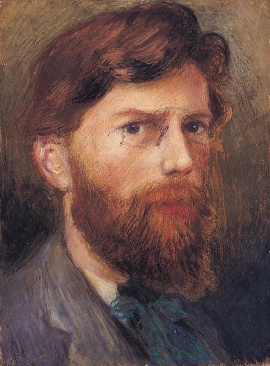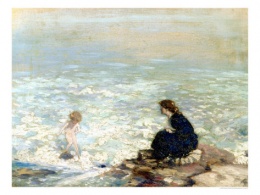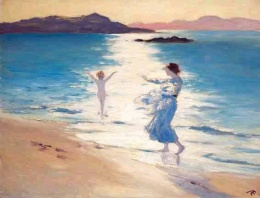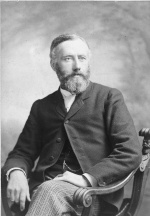George William Russell: Difference between revisions
| Line 47: | Line 47: | ||
* ''Vale and Other Poems''. London: Macmillan, 1931. | * ''Vale and Other Poems''. London: Macmillan, 1931. | ||
* ''Song and Its Fountains''. London: Macmillan, 1932. | * ''Song and Its Fountains''. London: Macmillan, 1932. | ||
* ''The Avatars''. 1933. | * ''The Avatars: A Futurist Fantasy''. London: Macmillan, 1933. Available at [https://babel.hathitrust.org/cgi/pt?id=uc1.$b441099 Hathitrust]. | ||
* ''Selected Poems''. 1935. | * ''Selected Poems''. 1935. | ||
* ''The Living Torch''. London: Macmillan, 1937. Edited by Monk Gibbon, with an introductory essay. | * ''The Living Torch''. London: Macmillan, 1937. Edited by Monk Gibbon, with an introductory essay. | ||
Revision as of 00:59, 20 October 2016
UNDER CONSTRUCTION
UNDER CONSTRUCTION
George William Russell (April 10, 1867 – July 17, 1935) was an eminent Irish poet, painter and essayist who wrote with the pseudonym Æ (sometimes written AE or A.E.). He was a political activist and a key figure in the Irish Literary Renaissance.
Early life and education
George William Russell was born April 10, 1867 at Lurgan, County Armagh, Ireland. His parents were Thomas Elias Russell and his wife Mary Anne Armstrong Russell. As a child George was very sensitive to the beauty of nature. His family lived in the Gate Lodge of a large estate, Brownlow House, owned by Lord Lurgan. George and his sister Mary Elizabeth ran freely about the property, and "the parkland, the lake and the backdrop of the towers of Brownlow House all had a profound effect on him."[1] At the age of four or five the boy experienced his first vision.
This was to become the essential feature of George Russell - he was a real visionary, not just in the sense that he had dreams for the future, but that he had actual visions in which he saw glimpses of the past and future that were glowingly real to him even though they were invisible to others.[2]
The family moved to Dublin when Thomas Russell was offered a job there. George attended Rathmines School. When he was seventeen, he suffered a devastating tragedy when his only sister Mary Elizabeth died. His education continued at Metropolitan School of Art, Dublin, where William Butler Yeats was also studying. Yeats introduced Russell to Theosophy.
Literary career
"Many of Russell’s poems are of a mystical nature reflecting his theosophical beliefs." several volumes of essays, pamphlets concerning cooperative farming compared to English poet Wordsworth and William Blake
Irish literary renaissance
"With John Eglinton' (W.K. Magee), Charles Johnston, W.B. Yeats and Charles Weekes, he was one of a group of young men who met together in Dublin some 20 to 25 years ago (1917), for the discussion and reading of the Vedas and Upanishads. These young enthusiasts created in time a regular centre of intellectual activity, which was translated in part into some of the most interesting literature of the Irish Revival. Their journals, The Irish Theosophist, The Internationalist, and The International Theosophist, contained, a great deal of matter, which has since taken a high place in modern Anglo-Irish literature. It was in the pages of those reviews that the first poems of `AE' were published, and to them we owe a great number of essays afterwards collected by John Eglinton under the title Pebbles from a Brook. Of all who contributed to that intellectual awakening few remain in the Hermetic Society, as it is now called...
From that Dublin group which included W.B. Yeats, John Todhunter, T.W. Rolleston, as well as those already mentioned, and also Fred J. Dick and his wife, "the slender-lovely candle of the Lord" of his poem, "How?", his own wife, Violet North, who died in 1932, Daniel N. Dunlop, Kenneth Morris, Arthur O'Dwyer, Paul Gregan, and subsequently J. M Synge, and Lady Gregory in their literary capacity, there came what is known as the Irish literary revival.
just then transferred to Eustace Street from Ely Place, and had also the sad experience of seeing the last of those lovely and unique creations of Russell's artistic genius and occult knowledge which decorated the walls of the Ely Place rooms, which were being dismantled, and in the hands of masons and plasterers who were busy destroying these priceless tokens of a new age. It was usual for some of this group of a Sunday to go up into the Dublin hills south of the city, and on one of these, Kilnashee, the Church of the Fairies, we would gather and commune with a Nature that was purer than it could be found in any structure of stone and mortar. Alaya, the Master-Soul, was the only leader recognized there, consequently there was no room for envy, jealousy, malice nor any of the uncharity that disturbs the councils of those who insist on following some earthly leader and despot.
What transpired from those talks and communings on Kilnashee is largely enshrined in The Irish Theosophist... "[3]
Katherine Tynan Hinkson wrote of 3 Upper Ely Place, "He painted the walls and ceilings of the Theosophical Society's rooms with his wonderful angels and fairies, his mystical dreams and fancies."[4]
Published works
- Homeward: Songs by the Way. 1894.
- The Divine Vision. 1904.
- The Mask of Apollo. 1904.
- New Poems. 1904.
- By Still Waters. 1906.
- Collected Poems. 1913.
- Frolic. London: J. Curwen & Sons, 1920. Musical score for voice and piano. Words by A.E.; music by Edgar L. Bainton.
- The Candle of Vision. London: Macmillan, 1918. Available at Internet Archive and Hathitrust.
- The Interpreters. 1922.
- Collected Poems, 2nd edition. 1926
- Midsummer Eve. 1928.
- Vale and Other Poems. London: Macmillan, 1931.
- Song and Its Fountains. London: Macmillan, 1932.
- The Avatars: A Futurist Fantasy. London: Macmillan, 1933. Available at Hathitrust.
- Selected Poems. 1935.
- The Living Torch. London: Macmillan, 1937. Edited by Monk Gibbon, with an introductory essay.
- Deirdre. Three-act play
- "Co-operation and Nationality" published by Maunsel of Dublin - pamphlet
Use of AE as pen name
The famous pseudonym by which Russell is known came from an experience when he was painting a visionary scene and heard the whispered word "Aeon." Soon afterward he glanced at an open book in a library and the same word caught his eye. He found that Aeon was a Gnostic term for the first created being. Russell began using Aeon, and then AE or Æ to sign manuscripts.
Art works
Political activities
"Russell was a political activist who threw himself wholeheartedly into Irish freedom movements, editing The Irish Statesman in 1923-30."
Theosophical Society involvement
Russell joined the Theosophical Society in 1887, and was a pupil of Madame Blavatsky when she was at Dublin the following year.[5] He was deeply affected by her ideas. For a few years he resided in a small community of Theosophists at 3 Upper Ely Place, Dublin. In 1898 he married Violet North, a fellow Theosophist. With Charles Johnston, his brother Lewis Johnston, William Butler Yeats, H. M. Magee, and others, Russell established the first Dublin Lodge of the Theosophical Society in April 1886.
Russell view of The Secret Doctrine
A month before he died, he wrote in a letter to the Irish author Sean O'Faolein:
You dismiss H. P. Blavatsky rather too easily as "hocus pocus." Nobody ever affected the thought of so many able men and women by "hocus pocus." The real source of her influence is to be found in The Secret Doctrine, a book on the religions of the world suggesting or disclosing an underlying unity between all great religions. It was a book which Maeterlinck said contained the most grandiose cosmogony in the world, and if you read it merely as a romantic compilation, it is one of the most exciting and stimulating books written for the last hundred years. It is paying a poor compliment to men like Yeats, Maeterlinck, and others, to men like Sir William Crookes, the greatest chemist of modern times, who was a member of her society, to Carter Blake, F.R.S., the anthropologist, and the scholars and scientists in many countries who read H. P. Blavatsky's books, to assume that they were attracted by "hocus pocus." If you are ever in the National Library, Kildare Street, and have a couple of hours to spare, you might dip into "The Proem" to The Secret Doctrine, and you will understand the secret of the influence of that extraordinary woman on her contemporaries.[6]
Russell and William Quan Judge
In a letter to Carrie Rea, Russell wrote of his friend William Quan Judge, one of the principal co-founders of the Theosophical Society in 1875:
I have sent you today... a book which I hope you will like Letters that have helped me. They are written by a man whom I consider the wisest and sweetest of any I have ever met W.Q.Judge (Z.I.Z.). I have more reverence for him than for an other human being I know of. I hope they will mean as much to you as to many of us. They are not badly written; but do not think of fine or beautiful phrases when reading the, but only of the things it is good to live with and ever to keep in mind. I think he says only things he knows.[7]
Russell and P. G. Bowen
One of Russell's friends was Captain P. G. Bowen. They met in 1922 when Bowen returned to Ireland after serving in South Africa and then in France during the First World War.
Before all else, AE was a Theosophist. With the crystal sincerity, and childlike simplicity which at all times distinguished him, he revealed to me that his aim in life overriding all else was to bring knowledge of the World of Spirit "where all hearts and minds are one" into the clouded sphere of human thought. He sought to bring it to Ireland, his own country, first and foremost, not because he ever forgot the equal needs of the rest of the world, but because he held, and held rightly, as every true Theosophist will agree, that we should cultivate the field which lies nearest to hand with the tool which stands most convenient. His literary pursuits were not followed as a way leading to gain and fame, things to which he was supremely indifferent, but because they furnished a ready channel created by "the instrument built up by many lives," (his personal selfhood), through which might flow "something of the rhythms of the ONE Life", and with their touch "restore to some sort of tune the jangled strings of human consciousness".[8]
Russell and Albert E. S. Smythe
Albert E. S. Smythe (1861-1947), an Irish immigrant to Canada, was a friend of W. Q. Judge and editor of The Canadian Theosophist. In 1931, Russell wrote to him in response to a previous letter:
The grey visitor was James M. Pryse who first instructed me in magic, conjuring up pictures in the astral light, and holding them before my inner eyes so that I could see initiation scenes, the evolution of the astral from the physical, the movement of cells and forces in the body. A good deal of what he wrote in the interpretation of the Apocalypse he showed me in the "glass". He was one of the few members of the T.S. who knew things for himself and had a good deal of occult power. He was really rather a mysterious person whose talk and writing had personal knowledge behind it. He, Judge, H.P.B., Subba Row,Damodar, and Jasper Niemand were the only members of T.S. who had their own sources of knowledge, as far as I can know. Most of the others wrote either out of intuition or retold what they had read: though Pryse said Archibald Keightley; who rarely wrote, knew a good deal. [9]
Hermetic Society
After the deaths and Madame Blavatsky in 1891 and then William Quan Judge in 1896, Russell left the Theosophical Society. He formed the Hermetic Society.
Other activities
Russell's early years in the countryside led to an interest in agriculture. In 1897 Russell joined the Irish Agricultural Organization Society, and continued his association for 25 years. From 1904 to 1923 he edited the Irish Homestead journal for farmers.
With Yeats, Lady Gregory, Edward Martyn, and John Millington Synge, Russell founded the Irish National Theatre Society in 1903 with funding from Annie Horniman. They bought a theater building and turned it into the Abbey Theatre. Plays by many eminent writers were staged, including works by Theosophist James Cousins and George Bernard Shaw, a close friend of Theosophist Annie Besant.
Later years
After 1930, Russell had become somewhat disillusioned about Ireland, feeling that the Roman Catholic Church was too powerful. His wife died in 1932, and he went to London.
He gave a helping hand to nearly every aspiring Irish writer. Helen Waddell, Patrick Kavanagh and James Joyce all benefited from his encouragement, as did P. L. Travers. James Joyce painted a vivid picture of AE in Ulysses, making fun of his eccentricities, but also, in one of the puns, which he so loved, he used the list of vowels A E I O U to express his indebtedness…
One of his lesser-known acts of support was to an American lady called Pamela Lyndon Travers. She came to England in 1924 and her interest in myth brought her into contact with Yeats and Russell. AE encouraged her to write and published her writing in "The Irish Statesman." P. L. Travers then went on to become famous in a rather different field as the author of the children's book, Mary Poppins, published in 1934…."[10]
In 1935 Russell went on a lecture tour of the USA to speak on "Rural Policies". He became ill in February and had to sail home in March. In July he had a major abdominal operation and it became obvious that he was terminally ill. For some time there had been coolness between Yeats and himself but he was much encouraged when Yeats sent a warm message. The rapid decline continued and he died on 17 July 1935 in a nursing home in Bournemouth.
His body was brought back to Ireland from London, accompanied on the train to Holyhead by a group of Irish writers including James Stephens and Helen Waddell. In Dublin his coffin lay in state in Plunkett House in Merrion Square. This was where he had worked for many years in the Irish Agricultural Organisation Society. He had a Church of Ireland funeral service, which was attended by W. B. Yeats, De Valera and Oliver Grogarty before being buried in Mount Jerome Cemetery"[11]
Other resources
The Union Index of Theosophical Periodicals lists 91 articles by or about George William Russell and 125 articles by AE (some of which are abbreviations for an author other than Russell).
- "AE" Poet and Theosophist by Boris de Zirkoff
- In Memoriam - George William Russell articles from the Canadian Theosophist.
- Harris, Philip S. "Russell, George William." Theosophical Encyclopedia (Quezon City, Philippines: Theosophical Publishing House, 2006), 542-543. Available at Theosopedia.
Notes
- ↑ Eric McIlroy, "George William Russell (Æ) 1867 - 1935" on Craigavon Historical Society web page.
- ↑ Eric McIlroy, "George William Russell (Æ) 1867 - 1935" on Craigavon Historical Society web page.
- ↑ Ernest A. Boyd, excerpted by A.E.S. Smythe in "'AE': Theosophist," The Canadian Theosophist 16.6 (August 15, 1935). See KatinkaHesselink web page.
- ↑ Katherine Tynan Hinkson, excerpted by A.E.S. Smythe in "'AE': Theosophist," The Canadian Theosophist 16.6 (August 15, 1935). See KatinkaHesselink web page.
- ↑ Philip S. Harris "Russell, George William," Theosophical Encyclopedia (Quezon City, Philippines: Theosophical Publishing House, 2006), 542-543. Available at Theosopedia.
- ↑ William Kirkpatrick Magee, A Memoir of AE: George William Russell, (London:Macmillan & Co., Ltd., 1937), 164-5.
- ↑ George W. Russell letter to Carrie Rea. September 6, 1894. Transcription the "Judge materials"of Boris de Zirkoff Papers. Records Series 22. Theosophical Society in America Archives.
- ↑ P. G. Bowen, "'AE': Theosophist," The Canadian Theosophist 16.6 (August 15, 1935). Quoted in [http://www.katinkahesselink.net/his/ae.html KatinkaHesselink web page.
- ↑ George William Russell letter to A.E.S. Smythe. September 20, 1931. Letter quoted in The Canadian Theosophist 16.6 (August 15, 1935). Also quoted in KatinkaHesselink web page.
- ↑ Eric McElroy, "George William Russell (Æ) 1867 - 1935" on Craigavon Historical Society web page.
- ↑ Eric McElroy, "George William Russell (Æ) 1867 - 1935" on Craigavon Historical Society web page.



